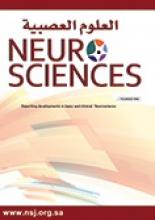Research ArticleOriginal Article
Open Access
Translation and validation of the Arabic version of the Boston carpal tunnel syndrome questionnaire
Habib Erensoy
Neurosciences Journal October 2019, 24 (4) 296-301; DOI: https://doi.org/10.17712/nsj.2019.4.20190014
Habib Erensoy
From the Department of Internal Medicine, King Saud University Medical City and College of Medicine, King Saud University, Riyadh, Kingdom of Saudi Arabia.
MD
References
- ↵
- Atroshi I,
- Gummesson C,
- Johnsson R,
- Ornstein E,
- Ranstam J,
- Rosén I
- ↵
- Shi Q,
- MacDermid JC
- ↵
- Pourmemari MH,
- Heliövaara M,
- Viikari-Juntura E,
- Shiri R
- ↵
- Levine DW,
- Simmons BP,
- Koris MJ,
- Daltroy LH,
- Hohl GG,
- Fossel AH,
- et al.
- ↵
- Atroshi I,
- Johnsson R,
- Sprinchorn A
- Nuckols TK,
- Conlon C,
- Robbins M,
- Dworsky M,
- Lai J,
- Roth CP,
- et al.
- ↵
- Chesterton LS,
- Blagojevic-Bucknall M,
- Burton C,
- Dziedzic KS,
- Davenport G,
- Jowett SM,
- et al.
- ↵
- Bessette L,
- Sangha O,
- Kuntz KM,
- Keller RB,
- Lew RA,
- Fossel AH,
- et al.
- ↵
- Imaeda T,
- Uchiyama S,
- Toh S,
- Wada T,
- Okinaga S,
- Sawaizumi T,
- et al.
- ↵
- Lue YJ,
- Lu YM,
- Lin GT,
- Liu YF
- Park DJ,
- Kang JH,
- Lee JW,
- Lee KE,
- Wen L,
- Kim TJ,
- et al.
- ↵
- Kim JK,
- Lim HM
- ↵
- Bougea A,
- Zambelis T,
- Voskou P,
- Katsika PZ,
- Tzavara C,
- Kokotis P,
- et al.
- ↵
- Alanazy MH
- ↵
- Guillemin F,
- Bombardier C,
- Beaton D
- ↵
- Beaton DE,
- Bombardier C,
- Guillemin F,
- Ferraz MB
- ↵
- Frost MH,
- Reeve BB,
- Liepa AM,
- Stauffer JW,
- Hays RD,
- Mayo/FDA Patient-Reported Outcomes Consensus Meeting Group
- ↵
- Terwee CB,
- Bot SDM,
- de Boer MR,
- van der Windt DAWM,
- Knol DL,
- Dekker J,
- et al.
- ↵
- King MT
- ↵
- Atroshi I,
- Lyrén PE,
- Gummesson C
- ↵
- Ortiz-Corredor F,
- Calambas N,
- Mendoza-Pulido C,
- Galeano J,
- Díaz-Ruíz J,
- Delgado O
- ↵
- Floyd FJ,
- Widaman KF
- ↵
- Lue YJ,
- Wu YY,
- Liu YF,
- Lin GT,
- Lu YM
- ↵
- Titchener AG,
- Fakis A,
- Tambe AA,
- Smith C,
- Hubbard RB,
- Clark DI
- Titchener AG,
- White JJE,
- Hinchliffe SR,
- Tambe AA,
- Hubbard RB,
- Clark DI
- ↵
- Cartwright MS,
- Yeboah S,
- Walker FO,
- Rosenbaum DA,
- Newman JC,
- Arcury TA,
- et al.
In this issue
Neurosciences Journal
Vol. 24, Issue 4
1 Oct 2019
Translation and validation of the Arabic version of the Boston carpal tunnel syndrome questionnaire
Habib Erensoy
Neurosciences Journal Oct 2019, 24 (4) 296-301; DOI: 10.17712/nsj.2019.4.20190014
Jump to section
Related Articles
- No related articles found.
Cited By...
- No citing articles found.





